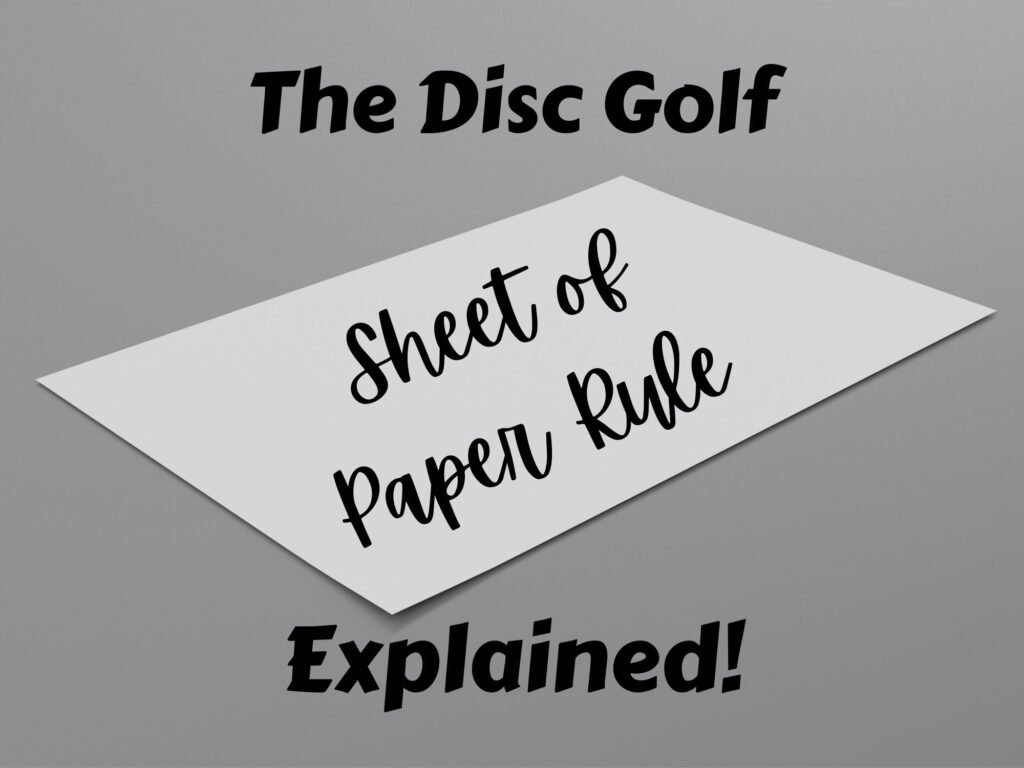When I was first starting out in disc golf, this idea of the “sheet of paper” rule caused me a lot of anxiety.
We’ll get into it more in depth in a moment, but basically, this rule is a guideline to help disc golfers envision where they can legally plant their foot when throwing a shot from the fairway.
The rule essentially states that a part of your plant foot has to be in this imaginary zone (called the “lie”) in order for you to avoid a one-stroke penalty.
It caused me anxiety because I wasn’t sure how I was supposed to successfully:
- Think of my shot and how I wanted to throw the disc.
- Do my run-up while looking at my target.
- And successfully land my plant foot in this relatively small “legal zone”.
I had visions of people yelling “foot fault” for every throw, incurring multiple penalties, and learning to hate disc golf just as quickly as I had grown to love it.
Luckily, that was not how things played out and I hope this post helps alleviate some similar anxieties (if you had them) and helps explain how this “sheet of paper” rule applies to you when you’re playing disc golf with friends or in a tournament.
Let’s begin!
The “Sheet of Paper” Rule Explained
Technically, it’s not actually a sheet of paper. It’s actually a 20 cm by 30 cm (7.87″ x 11.81″) rectangle placed vertically (see image) behind the marker or the disc.

In practice, it’s close enough to a typical sheet of paper (8.5″ x 11″) that the sheet of paper visual works well.
And luckily, most disc golfers don’t bring their measuring tape to the course with them.
So, in most instances it’s more of a “guideline” that you should follow.
Technically, the rule states that you need to have a “point of contact” (it could, in theory be a hand or elbow) in that rectangle and no other point of contact in front of it.
But in most instances the rule is basically just this:
You have to put some part of your plant foot in that rectangle when you throw.
Now, let’s look how it applies to you on the course and especially in tournament play.
Frequency of Foot Fault Calls
I have not played a ton of tournaments, and I don’t play with very high stakes.
My understanding is that the more competitive that you get, the more concerned people get with rules like foot faults.

In my own brief experience, I have not seen anyone called for a foot fault with regards to a fairway shot.
Remember, in order to incur a one-stroke penalty, two people on your card have to call the penalty.
So, my take away is don’t let it be a deterrent to playing in organized events. And if you find yourself being called for frequent foot faults by different people, then it’s probably something you should practice.
For a complete list of foot fault infractions you can go here.
Foot fault calls happen far less frequently than I thought. With time, it’s a skill you can practice and improve upon as well.
Helpful Reminders
Here are a few helpful reminders to give you a visual for the sheet of paper rule (without having to lay down an actual sheet of paper).
Reminder #1 – Twenty centimeters is about the width of most discs (discs are usually about 21 cm wide.)
This just means that the width of the lie is about the width of a disc.
Reminder #2 – Thirty cm is about 1 foot.
That just means that the depth of the lie is about a size-12 shoe length behind the disc.
Keep these landmarks in mind and you can feel confident you are following the guidelines for the sheet of paper rule when you are out on the course!
The Disc Golf Sheet of Paper Rule – In Summary
When you are first starting out in disc golf, there can be a lot on your mind for each shot.
You can find yourself thinking about your form, your intended line, the wind, the hills, etc.
Adding foot faults and landing zones for your foot to that list can be daunting. For some people it’s a barrier to entry for entering organized disc golf events.
Don’t let it prevent you from playing!
It used to bother me, but I’ve found that in less competitive events, it’s hardly ever called.
And as you gain experience, you’ll get better at it naturally.
Also, most disc golfers are pretty great about helping you out and teaching you.
That doesn’t mean, however, that you shouldn’t try and comply with the rule for each shot. You should.
Practice landing part of your plant foot in that 20 cm x 30 cm (disc width x 1 foot) for each shot from the fairway.
Building good habits will pay dividends later as you improve and rise rapidly up the disc golf ranks!
Thanks for reading! If this helped or if you want any other comments. As always, consider subscribing to my newsletter. It’s free, with no SPAM, AND it automatically enters you into a raffle to win $50 gift cards at Infinitediscs.com. I look forward to having you aboard!
Check Out These Other Posts!
- Lone Star Disc Has a Great Lineup for Beginners!

- The MVP Trail Disc – Should you Get it?

- The 3 Best Disc Golf Bags with Coolers For Any Budget!

- Best Disc Golf Misprints for Your Bag!

- Top 5 Fun Disc Golf Mystery Boxes!

- Top 5 Backpack Disc Golf Bags for 2025!

- 5 Best Disc Golf Cart Accessories!

- The Best Disc Golf Putter Pouch For Your Cart!

- Top Disc Golf Basket Lights For Night!


